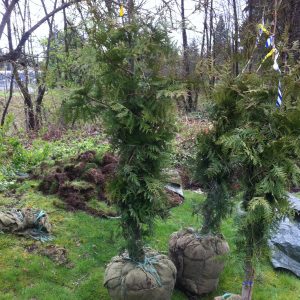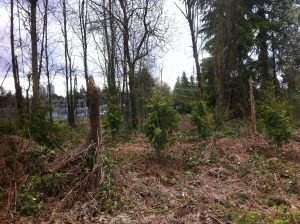I love planting trees and shrubs. The world can always use more trees and shrubs. But don’t dismiss tree planting as easy. It has to be done right. The International Society of Arboriculture (ISA) sells a book called “The science of tree planting.” Case closed.
Our mission today was to plant trees on a wild bank to provide residents with a screen. As the trees mature they should obscure the power station visible in the distance.
We planted two tree species (Acer rubrum and Thuja plicata) and one shrub (Pieris japonica.)
Step 1 At the nursery
Always be nice to the workers at the nursery. You don’t want them loading your precious plants like pigs. My job was to count the plants and anchor them in the back of the truck. The key is to always handle your trees by the root ball not by the stem. Taking liberties with the stems could damage the tree.
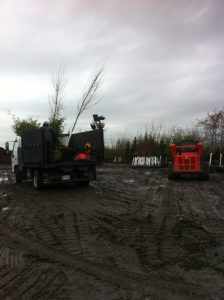
I love tree nurseries! You can improve your plant ID skills and off-road in company trucks. Handle your trees with care.
Step 2 Digging
We predetermined our hole locations the day before. The digging was awful because of the wildness of the bank. The bank was covered with woody debris, ivy and bramble. For this reason I used a tarp for “parking” soil from the hole. I used a shovel to measure the size of the root ball. I also had to adjust for the string and burlap wrapped around the stem. The root flare is actually lower than where the string and burlap meet.
Step 3 Placing the tree
Once the hole was ready, we carefully placed the tree in the hole. Remember to handle the trees by the root ball NOT by the stem. Once the placement is correct, it’s time to anchor the tree by backfilling the hole to about half way. Another key is to backfill your planting holes with the same material you dug up and placed on your tarp. Some people are tempted to backfill their holes with beautiful new soil but it doesn’t work. Water finds it much easier to enter your planting hole than the surrounding soil and your hole will become waterlogged. This will turn your new tree into a joystick and it will crash down eventually. Use the original material from your digging.
Step 4 Removing string, burlap and wire
Once our tree was anchored in the hole, we cut and removed the string. The top of the wire cage is either cut away or bent back into the hole. The top third of the burlap is also removed. Use scissors or a knife.
Now you’re ready to complete backfilling your hole. Always make sure soil doesn’t go over the root flare. The root flare should be visible. Mounding soil over your stem leads to problems.
Cut all strings on the Thuja plicata stems to free the branches.
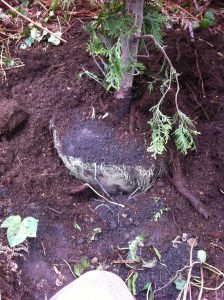
Partially backfilled for anchoring; note removed burlap and string, wire bent back and tree root flare located.
Step 5 Final touches
Remove all flagging and name tags. Top dress with aged mulch or soil amender. Also take pictures for your files. Monitor your trees just in case if staking is required. The Acer rubrums are tall and if they move, they will get staked. Just remember to remove the stakes after one season. Leaving them on longer prevents the tree from forming reaction wood.
With April rains expected to continue, no watering was required but it is a consideration if you’re planting during a warm, sunny spell.
Pick up any garbage and do a courtesy blow of your work area.
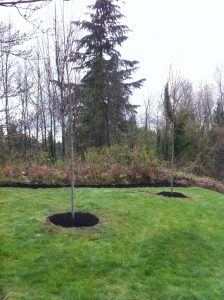
Two Acer rubrum trees. Note top-dressed tree wells. No staking required but landscape maintenance crews will monitor.
I’m curious to see how many seasons it will take for the trees to obliterate the view of the power station.


